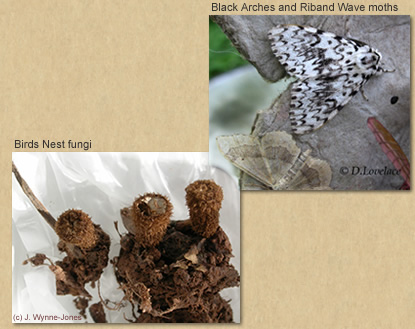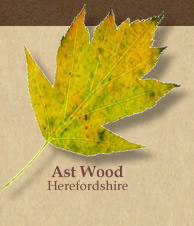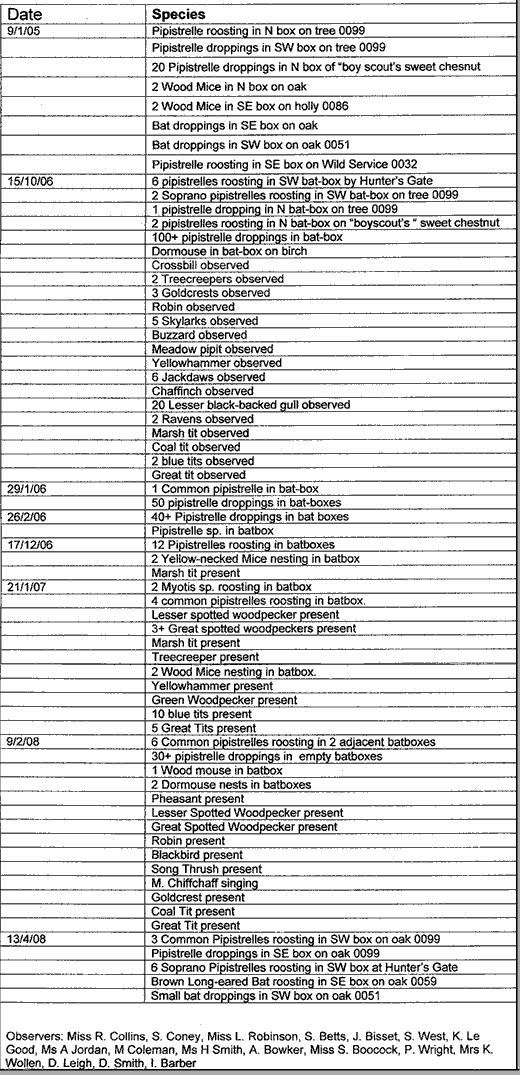

| DATE: 30th Aug 2008, 8pm to 1:00am | ||||
| WEATHER: clear with no wind; Temperature: start 17C, end 13C | ||||
| TOTAL SPECIES: 87 | ||||
| TRAPS USED: 4 x 80W MV and 2 x 125W | ||||
| KEY: S = Status -> H = Hfd: uncommon; U = UK BAP research only | ||||
| Scientific Name | Qty | B&F # | S | Vernacular |
|---|---|---|---|---|
| Abraxas grossulariata | 4 | 1884 | Magpie Moth | |
| Acleris cristana | 1 | 1054 | H | a tortrix moth |
| Acleris emargana | 1 | 1062 | a tortrix moth | |
| Acleris laterana | 21 | 1038 | a tortrix moth | |
| Acleris variegana | 1 | 1048 | Garden Rose Tortrix | |
| Acrobasis consociella | 1 | 1437 | a pyralid moth | |
| Agapeta hamana | 2 | 937 | a micro-moth | |
| Agonopterix arenella | 2 | 697 | a micro-moth | |
| Agriphila straminella | 6 | 1304 | a pyralid moth | |
| Agriphila tristella | 8 | 1305 | a pyralid moth | |
| Aleimma loeflingiana | 1 | 1032 | a tortrix moth | |
| Amphipyra berbera svensson | 1 | 2298 | Svensson's Copper Underwing | |
| Amphipyra pyramidea | 6 | 2297 | Copper Underwing | |
| Argyresthia bonnetella | 1 | 421 | a small ermine moth | |
| Argyresthia brockeella | 3 | 410 | a small ermine moth | |
| Argyresthia goedartella | 2 | 411 | a small ermine moth | |
| Argyresthia semifusca | 4 | 419 | a small ermine moth | |
| Atethmia centrago | 2 | 2269 | U | Centre-barred Sallow |
| Autographa gamma | 1 | 2441 | Silver Y | |
| Blastobasis lignea | 16 | 873 | a micro-moth | |
| Caloptilia robustella | 1 | 287 | a micro-moth | |
| Caloptilia syringella | 1 | 293 | a micro-moth | |
| Campaea margaritata | 7 | 1961 | Light Emerald | |
| Camptogramma bilineata bilineata | 1 | 1742 | Yellow Shell | |
| Carcina quercana | 9 | 658 | a micro-moth | |
| Chloroclysta truncata | 32 | 1764 | Common Marbled Carpet | |
| Chloroclystis v-ata | 1 | 1858 | V-Pug | |
| Cnephasia incertana | 1 | 1024 | Light Grey Tortrix | |
| Colostygia pectinataria | 21 | 1776 | Green Carpet | |
| Cosmorhoe ocellata | 8 | 1752 | Purple Bar | |
| Cyclophora punctaria | 4 | 1680 | H | Maiden's Blush |
| Cydia splendana | 11 | 1260 | a tortrix moth | |
| Cymatophorima diluta | 46 | 1658 | U | Oak Lutestring |
| Diarsia rubi | 17 | 2123 | U | Small Square-spot |
| Ecliptopera silaceata | 1 | 1759 | U | Small Phoenix |
| Ecliptopera silaceata | 15 | 1759 | U | Small Phoenix |
| Eilema deplana | 2 | 2049 | Buff Footman | |
| Eilema lurideola | 1 | 2050 | Common Footman | |
| Ennomos fuscantaria | 3 | 1914 | U | Dusky Thorn |
| Epinotia brunnichana | 3 | 1155 | a tortrix moth | |
| Epinotia nisella | 2 | 1138 | a tortrix moth | |
| Epinotia ramella | 7 | 1134 | a tortrix moth | |
| Epinotia trigonella | 2 | 1151 | a tortrix moth | |
| Eudonia angustea | 1 | 1342 | H | a pyralid moth |
| Eudonia mercurella | 3 | 1344 | a pyralid moth | |
| Eupithecia absinthiata | 3 | 1830 | Wormwood Pug | |
| Euproctis similis | 1 | 2030 | Yellow-tail | |
| Euzophera pinguis | 1 | 1470 | a pyralid moth | |
| Gymnoscelis rufifasciata | 3 | 1862 | Double-striped Pug | |
| Hedya dimidioalba | 2 | 1083 | Marbled Orchard Tortrix | |
| Hoplodrina ambigua | 1 | 2384 | Vine's Rustic | |
| Horisme tersata | 1 | 1782 | The Fern | |
| Hydriomena furcata | 1 | 1777 | July Highflyer | |
| Hypatima rhomboidella | 1 | 858 | a micro-moth | |
| Hypena proboscidalis | 3 | 2477 | Snout | |
| Hypsopygia costalis | 1 | 1413 | Gold Triangle | |
| Idaea aversata | 1 | 1713 | Riband Wave | |
| Idaea dimidiata | 6 | 1708 | Single-dotted Wave | |
| Lymantria monacha | 11 | 2033 | Black Arches | |
| Mesapamea secalis | 3 | 2343 | Common Rustic | |
| Mesapamea secalis | 6 | 2343 | Common Rustic | |
| Mythimna pallens | 9 | 2199 | Common Wainscot | |
| Noctua comes | 2 | 2109 | Lesser Yellow Underwing | |
| Noctua janthe | 5 | 2111 | Lesser Broad Bordered Yellow Underwing | |
| Noctua pronuba | 46 | 2107 | Large Yellow Underwing | |
| Nymphula nymphaeata | 5 | 1345 | Brown China-mark | |
| Ochropleura plecta | 15 | 2102 | Flame Shoulder | |
| Olethreutes lacunana | 6 | 1076 | a tortrix moth | |
| Opisthograptis luteolata | 18 | 1906 | Brimstone Moth | |
| Orgyia antiqua | 2 | 2026 | Vapourer | |
| Pandemis corylana | 25 | 969 | Chequered Fruit-tree Tortrix | |
| Peribatodes rhomboidaria | 3 | 1937 | Willow Beauty | |
| Perizoma alchemillata | 1 | 1803 | Small Rivulet | |
| Phlogophora meticulosa | 4 | 2306 | Angle Shades | |
| Pleuroptya ruralis | 6 | 1405 | Mother of Pearl | |
| Pterostoma palpina | 1 | 2011 | Pale Prominent | |
| Pyrausta aurata | 1 | 1361 | a pyralid moth | |
| Rivula sericealis | 14 | 2474 | H | Straw Dot |
| Scoparia ambigualis | 12 | 1334 | a pyralid moth | |
| Stenolechia gemmella | 4 | 755 | H | a micro-moth |
| Thera britannica | 2 | 1769 | Spruce Carpet | |
| Trichiura crataegi | 1 | 1632 | U | Pale Eggar |
| Xanthorhoe designata | 12 | 1722 | Flame Carpet | |
| Xanthorhoe fluctuata | 3 | 1728 | Garden Carpet | |
| Xanthorhoe spadicearia | 1 | 1724 | Red Twin-spot Carpet | |
| Xestia c-nigrum | 32 | 2126 | Setaceous Hebrew Character | |
| Xestia xanthographa | 7 | 2134 | Square-spot Rustic | |
Click a row to search Wikipedia for an entry on the species.
A much studied wood...
Down the years, Ast Wood has had official and unoffical surveys made of many things that live there, and had various studies and reports written about it. There have been ecological and economic surveys; gloomy post-war Forestry Commission assessments; maps of how large tracts of the wood could be obliterated and smoothed and shaped into grass golf course fairways; a late twentieth century overview of the present and future importance of the wood as it is, by a distinguished academic and author on ancient woodland; a twenty-first century 'rapid site identification' survey by a Herefordshire Council archaeologist. There is also a description of the wood on pages 181-3 of The Wild Woods by Peter Marren (David and Charles/NCC 1992).

June 1990 overview of Ast Wood, by Charles Watkins:
Ast Wood is one of the most important surviving areas of ancient semi-natural woodland in eastern Herefordshire. It is about 45 acres in size. Until the early seventies it was bigger, but 20 acres or so of the south western section of the wood were cleared and converted to agricultural land at that time. Most of the remaining woodland is surrounded by a distinct wood bank. This is of particular archaeological interest as many ancient woodlands in Herefordshire do not have distinct wood banks.
The wood is a remarkably attractive and diverse ancient woodland. There are many interesting trees including a very large number of wild service trees. This species of tree is one of the best indicators of ancient woodland. There are also some very large small leaved limes; huge old ash coppice stools; large alder stools along the brooks which rise in the wood; and also oak, yew, aspen, chestnut and cherry.
There is also a very good ground flora with expanses of bluebells and wild daffodils, wood anemone, dog's mercury and wood sorrel. There is a large population of herb paris, a key ancient woodland indicator species. Woodpeckers, both green and spotted are frequently heard and there is an excellent range of characteristic woodland birds such as tree-creepers, chiff-chaff and so forth.
Woodland management records on the nineteenth century show that the wood was regularly coppiced at from twelve to fourteen years' growth. At this time the wood was part of the Eastnor Estate and there is a fine collection of records relating to coppicing and woodland management. The poles were used as hop poles in the local hop yards.
The characteristics of the woodland flora, togther with the setting of the wood and its topography are strong evidence that Ast Wood is primary ancient woodland. Every effort should be made to protect it.
© Charles Watkins, author of Woodland Management and Conservation (David and Charles/NCC 1990); now Professor of Rural Geography, Nottingham University.

